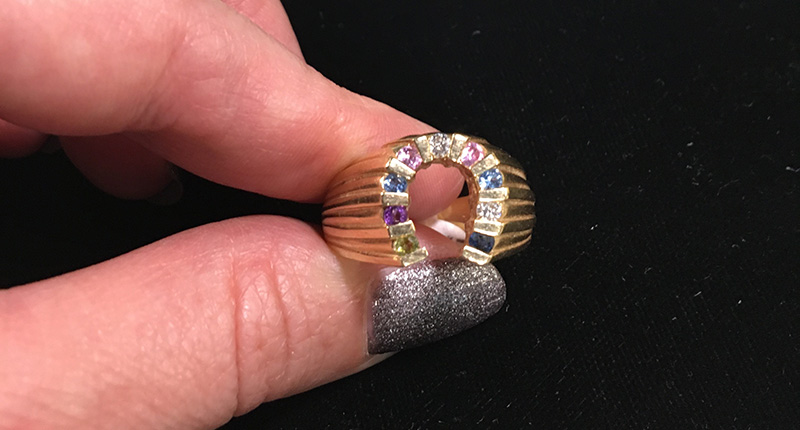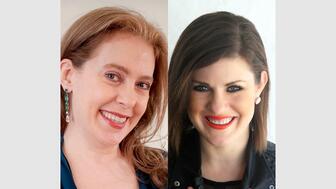The special-edition egg pendant ingested in a New Zealand jewelry store was recovered after a six-day wait.
5 Tips for Buying Antique and Estate Jewelry
Dealers at The Original Miami Beach Antique Show dish on the telltale signs that something is a reproduction and the importance of experience.

Last week I was in Miami for The Original Miami Beach Antique Show and the following happened, in this order:
--I gave a talk on the history behind the squash blossom necklace at the Jewelry History Series with minimal heckling;
--I heard a number of other informative presentations, including one on World War II “Sweetheart Jewelry” by Jan Krulick and another from John P. Walcher of Chicago auction house Toomey & Co. on the jewelry made in the Windy City during the Arts & Crafts movement, particularly at The Kalo Shop;
--I saw some incredible jewelry (some of which is pictured here) and made great new friends; and
--I dipped my toes in the Atlantic Ocean (translation: I attempted to get only my feet wet but underestimated the waves and ended up with jeans soaked to the knees.)
Along the way, I stopped to chat with dealers at the show to get their advice on antique and estate jewelry buying for those who are opening a store (brick-and-mortar or online), taking over the buying responsibilities at an established store or looking to get into the business.
The advice I heard repeated most often wasn’t so much advice as it was a statement of fact: second-hand buying is mainly about experience. Being a good buyer comes from years of looking at and handling jewelry and, as with anything else, making mistakes along the way.
“The more you handle, the better you get,” New York-based dealer Hartley Brown told me at his booth while allowing me to handle some beautiful mandarin garnets. “It’s experience.”
And when I stopped by the booth of Kurt Rother of Los Angeles-based Excalibur on Saturday afternoon and asked him how to tell if a piece of allegedly antique jewelry is a reproduction, he summed it up like this: “years of experience.”
There were, however, a few specific tips that I was able to glean from the dealers I spoke with in Miami.
1. Examine the jewelry from all angles, carefully.
Look at the back of a piece of jewelry, Brown advised, not just the front. Good antique jewelry will be expertly finished but, as we will get to under No. 2, not without signs of wear.
Diane Richardson of The Gold Hatpin in Oak Park, Illinois, said to always examine a piece of jewelry with a loupe before buying—look at the stamp, check the findings, check the prongs.
When possible, Richardson said, try on the jewelry to see if its lays right and is comfortable. “If something doesn’t work, factor that into negotiating the price,” she said.
2. If it’s old, it should look it.
While Rother’s immediate answer to my question about spotting reproductions was “experience,” he did allow that there are a few obvious signs that a piece is not as old as advertised, chief among them being no signs of wear.
If, for example, there are loops connecting two gemstones in an earring, there should be a small groove where the loops connect. Pointing to the necklace I was wearing that day, a gold medallion passed down to me by my grandmother, he noted that I would see the same on the bail.
Khan Ismael, an independent British dealer working at the booth of Lowther Antiques, said to check the prongs to see if they show signs of wear and, also, to look at the enamel. If a piece of jewelry is supposed to be 200 years old and the enamel is pristine, then something is off.
He added that weight and size also are good indicators of age.
A lot of older jewelry—Georgian chain, for example—was very light.
Antique cuffs are often small because people had smaller wrists, while antique rings tend to the extremes.
They are either small (because, again, people were smaller) or large because they were made to be worn over gloves. It is unusual, he said, to be able to get antique rings in the average rings sizes of today, like a 6 or a 7.
3. Money, money, money.
I received a few tips regarding price, starting with this one from Ismael, who is widely known (as I discovered many at the people at this show are) by his Instagram handle, @ishyantiques: “If something seems too good to be true, it probably is.”
Ismael said buyers have to think logically when they are shopping and not get swept up in a piece; if the price seems too low, there is probably a reason for it.
Richardson, along with Walcher, of Toomey & Co., advised shopping around to compare and contrast the items and prices available at the various booths.
Walcher added this, which I think is solid advice for shopping anywhere: “Don’t buy the first thing you see, unless you know you can’t live without it and believe it to be a fair price. Nothing is worse than buyer’s remorse.”
4. Use outside resources.
Richardson recommended reading up on antique jewelry before buying. Lang’s online Antique Jewelry University is not a bad place to start, and I learned of a website at the show dedicated entirely to mourning jewelry, ArtofMourning.com.
Walcher advised bringing along someone more experienced while Rother, whose family was not in the jewelry business, learned from others along the way: “If someone was willing to tell me something, I was willing to listen.”

5. Buy what you love … or don’t.
This last bit of advice was interesting to me, as it seems to go against what retailers are advised to do when buying new jewelry, which is: buy what is selling in the store, not what appeals to you personally.
The dealers at the show, however, argued that with antique and estate pieces, it’s different. It’s not the same as filling in gaps in pre-made lines and collections. It’s about finding pieces you are passionate about because that passion will come through to your customers.
“People start out, often, buying what is popular, but if you buy what you like, you can be enthusiastic about selling it,” Richardson said.
Mitch Weisz also advised buying what you like, noting “If you think it’s wonderful, then customers will too.”
And Ismael offered this, which I would advise practicing with some measure of restraint: “Buy what you like because if you don’t sell it, you can keep it.”
I asked a retailer about this, Ron Samuelson of Samuelson’s Diamonds, who attended the Miami show with his store’s new director of estate jewelry, Allie Lopato.
He said while he can see the intrinsic value in older items, he doesn’t advise buying estate and antique jewelry based on personal taste. Instead, he recommends checking inventory data to see what’s selling, just as you would for new lines.
“You buy something you love, but is everyone else going really going to love it?” he asked. “Everybody has inventory issues. Whether it’s secondhand or not, you don’t want to get stuck with an item that you really loved that not everyone else loved.”
The Latest

The “Love and Desire” campaign is inspired by the magic that follows when one’s heart leads the way, said the brand.

Two awardees will receive free tuition for an educational course at the Swiss lab, with flights and lodging included.

How Jewelers of America’s 20 Under 40 are leading to ensure a brighter future for the jewelry industry.

Berta de Pablos-Barbier will replace Alexander Lacik at the start of January, two months earlier than expected.


Sotheby’s held its first two jewelry sales at the Breuer building last week, and they totaled nearly $44 million.

Winners will receive free registration and lodging for its fourth annual event in Detroit.

Roseco’s 704-page catalog showcases new lab-grown diamonds, findings, tools & more—available in print or interactive digital editions.

Here are six ideas for making more engaging content for Instagram Reels and TikTok, courtesy of Duvall O’Steen and Jen Cullen Williams.

The honorees include a notable jewelry brand, an industry veteran, and an independent retailer.

Carlos Jose Hernandez and Joshua Zuazo were sentenced to life without the possibility of parole in the 2024 murder of Hussein “Sam” Murray.

Yood will serve alongside Eduard Stefanescu, the sustainability manager for C.Hafner, a precious metals refiner in Germany.

The New Orleans jeweler is also hosting pop-up jewelry boutiques in New York City and Dallas.

Set in a Tiffany & Co. necklace, it sold for $4.2 million, the highest price and price per carat paid for a Paraíba tourmaline at auction.

The jeweler’s “Deep Freeze” display showcases its iconic jewelry designs frozen in a vintage icebox.

Take luxury gifting to new heights this holiday season with the jeweler’s showstopping 12-carat sphene ring.

This year's theme is “Unveiling the Depths of the Ocean.”

In its annual report, Pinterest noted an increase in searches for brooches, heirloom jewelry, and ‘80s luxury.

Starting Jan. 1, customers can request the service for opal, peridot, and demantoid garnet.

The 111-year-old retailer celebrated the opening of its new location in Salem, New Hampshire, which is its third store in the state.

The new catalog features its most popular chains as well as new styles.

The filmmaker’s personal F.P. Journe “FFC” prototype was the star of Phillips’ recent record-setting watch auction in New York.

The new location in the Design District pays homage to Miami’s Art Deco heritage and its connection to the ocean.

Inflations, tariffs, and politics—including the government shutdown—were among consumers’ top concerns last month.

“Longtime favorite” presenters, as well as first-time speakers, will lead talks and workshops at the annual event in Tucson next year.

Silas Smith of Meridian Metalworks won the challenge with his pendant that blends Australian and American landscapes.

The sale of the 31.68-carat, sunset-hued stone was part of Sotheby’s first series of events and auctions in Abu Dhabi.


























